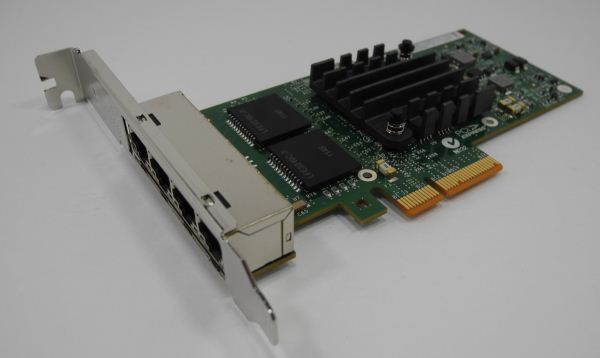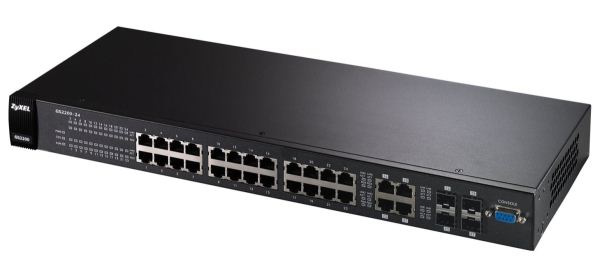Building the 2012 AnandTech SMB / SOHO NAS Testbed
by Ganesh T S on September 5, 2012 6:00 PM EST- Posted in
- IT Computing
- Storage
- NAS
The Asus Z9PE-D8 WS has 2 GbE ports. However, we have several VMs trying to stress the NAS under test. Sharing two GbE links across 12 VMs was never going to be a suitable solution. The testbed used in earlier reviews had an Intel ESA-I340 quad-port GbE network adapter. Based on the Gigabit 82580, it has a PCIe 2.0 x4 connection enabling it to provide maximum bidirectional throughput for all the four GbE ports.
The Z9PE-D8 WS has 7 PCIe slots, and we decided to fill up three of them with the Intel ESA-I340 cards. They provided a total of twelve physical GbE ports, one for each VM. The ESA I-340 has a full height form factor, but also comes with a low profile bracket. One of the interesting aspects of the I340 server adapter is the VMDq (Virtual Machine Device Queue). It reduces I/O overhead in the hypervisor (and lowers CPU usage) by maintaining hardware queues for data packets sorted by their destination and sending them later to the hypervisor for forwarding to the appropriate VM. Even though we had the VMDq feature enabled in the settings for all the adapters, it probably had negligible effect on the CPU usage in our workloads because we had each VM reserving one port exclusively for its own use. The host machine itself connected to the network through one of the native GbE ports on the motherboard.
Between the NAS testbed and the NAS under test, it is essential that we have a switch capable of standing up to the stressful network traffic. Our switch of choice was one of the 24-port managed enterprise models from ZyXel, the GS2200-24. Even though it is advertised as a 24-port model, it actually has 4 extra ports with dual personalities (i.e, both copper and optical SFP).
The switch has all the necessary features for an L2 managed model including VLANs, CoS/QoS, port trunking and bandwidth control. Port trunking / 802.3ad LACP aggregation is essential because NASes with dual GbE ports provide that as an option to increase performance. Even though a NAS might support link aggregation, it is of no use if the switch to which it is connected doesn’t aggregate the connected ports.












74 Comments
View All Comments
dertechie - Wednesday, September 5, 2012 - link
That is a helluva test bench.I'd love to see what a HP N40L Microserver does with 4 disks in it if you throw that at it (use the on-motherboard USB port for the OS). It's certainly not a plug-and-play solution like most NAS boxes, but assuming the performance is there it should be a far more flexible one for the money if you throw a *nix based OS on it.
bsd228 - Wednesday, September 5, 2012 - link
I've taken advantage of the 5th internal port of the N36L to add an SSD that is used by ZFS for both read and write caching. Strictly speaking, mirrored write caches are advised, but it's connected to a UPS to eliminate much of that risk.I think HP has given us the perfect platform for low power, high performance with flexibility.
extide - Thursday, September 6, 2012 - link
Cache? or L2ARC?Mirrored Cache drives are NOT suggested for ZFS, but Mirrored L2ARC devices are.
coder543 - Wednesday, September 5, 2012 - link
running Windows Server.........ganeshts - Wednesday, September 5, 2012 - link
What alternatives do you have in mind?We needed a platform which was well supported by the motherboard. To tell the truth, I found Hyper-V and the virtualization infrrastructure to be really good and easy to use compared to VMWare's offerings.
ender8282 - Wednesday, September 5, 2012 - link
I assume coder543 was going for a Linux based host, and possibly Linux based clients as well. If you had gone with Linux you wouldn't have needed extra software for SSH or the ram disk. It even looks like IOMeter is supported for Linux. Had you gone that route you likely could have automated the whole task so that it was just a matter of typing go on the host and coming back hours later to collect the results. OTOH most of your audience is probably more likely to be using Windows clients so it probably makes more sense to provide information clearly relevant to the average reader.I found the article interesting. The one thing that I'd be curious about is whether or not there were any major performance differences using Samba/CIFS type shares vs NFS, or a mixture of the two.
I'd love to see more Linux coverage in general, but I respect that you know your audience and write the articles that they generally want to read.
Great Job keep it up!
Ratman6161 - Thursday, September 6, 2012 - link
I should run on that platform just great. On the other hand, when all is said and done, as nice as this setup is, to me it is basically a full blown server/virtualization platform; not really a "NAS" at all. I would typically think of a NAS as being a dedicated storage device - possibly used as an IScsi target with the brains of the operation living elsewhere.ganeshts - Thursday, September 6, 2012 - link
This is a testbed for evaluating NAS units, not a NAS. Not sure why readers are getting an impression that this is a NAS by itself.bsd228 - Wednesday, September 5, 2012 - link
Ganesh- I think this test bed sets up very well for testing the $500-1000 4 bay type NAS devices we've been seeing of late that could actually serve a small office. However, I'm less sure that it delivers meaningful data to the home crowd. Like with your SSD tests, I see a place for a "light" load versus the heavy. I think testing against 4 VMs with, for sake of example, the following load types would work:1- 2 VMs streaming video - 1 DVD, 1 H.264 HDTV - are there any interruptions?
2- 1 VM streaming audio off a mt-daapd (or actual itunes since you're using windows as the server) - again, is there any dropoffs.
3- same VM as #2 is also doing content creation - like importing 1000 RAW images into Lightroom using this storage space
4- last VM is copying large files (or small) to the storage server.
The Thecus 4800 should handle this with ease, but there are many cheaper solutions out there that may or may not meet this level of need. I got so tired of poorly performing consumer units that 4 years ago I switched to an AMD x2 4800 running solaris, and more recently to the HP36L and 40L. At $300 plus $60 for 8 gigs of ECC I think this is a better value than the Thecus for those who can run solaris or even Windows Home Server. You're not reliant on the release of modules to support a particular service.
Also, it seems that all of these benchmarks are based on SMB transfers. It's worth checking to see if nfs and iscsi performance (when made available by the NAS) shows different numbers. In the past, it certainly did, especially on the consumer devices where NFS smoked SMB1. But perhaps this is a moot point with SMB2/windows 7 where it seems like the NIC or the hard drives are the limiting factors, not the transfer protocol.
Rick83 - Thursday, September 6, 2012 - link
I agreem test the different protocols provided by the devices.iSCSI, SMB, NFS as well as the media streaming protocols, FTP and whatever else it offers.
If encrypted transfers are offered, test those as well (eg. sshfs / scp).
Additionally, have a look at one of the cluster-ssh solutions, that allows simultaneous connections/commands to all machines.